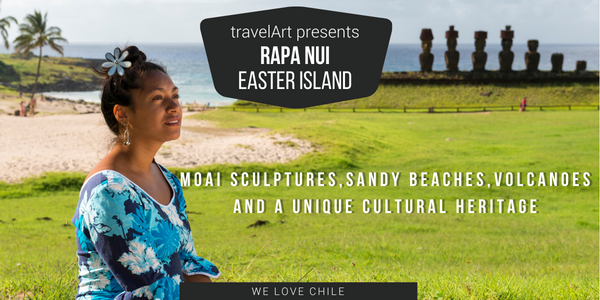
Rapa Nui, the “navel of the world”, is located in the middle of the Pacific Ocean. Barely 3,800km from the mainland and 4,200km from Tahiti, Easter Island is the place on earth furthest from any other inhabited location. Long isolated from the rest of the world, this less than 25km long and 25km wide island has a rich history, art and language. The island has the shape of a triangle and is home to extinct volcanic cones on each of the three island peaks.
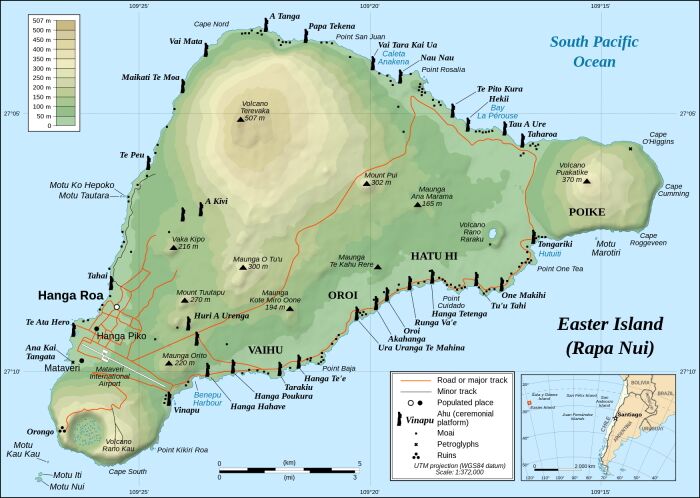
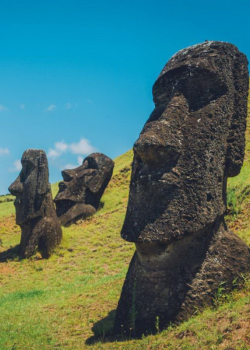 Because of its small size and rich cultural heritage, the entire island now seems like a kind of open-air museum with more than 1000 moai statues, cult sites and ancient cave dwellings open for viewing.
Because of its small size and rich cultural heritage, the entire island now seems like a kind of open-air museum with more than 1000 moai statues, cult sites and ancient cave dwellings open for viewing.
A large part of Easter Island is now a national park and UNESCO World Heritage Site. The Rapa Nui National Park was established in 1935 to protect archaeological sites throughout the island. Today the park covers almost the entire island. Hanga Roa is the small capital of Rapa Nui. Most of the 8,000 inhabitants of the island live here.
Temperatures on Easter Island are subtropical and with no changing seasons, a journey to the island is worthwhile throughout the year. The months of May to October are slightly cooler than the months between November and April, and the most rainfall occurs in April and May.
If you want to experience first-hand the exciting culture of the island’s inhabitants, you will be fascinated by the traditional Tapati festival. This festival takes place every year in February and the inhabitants of Easter Island present their music, gastronomy, art, mythology as well as their physical skills within the framework of various sports competitions of individual local teams.
Highlights
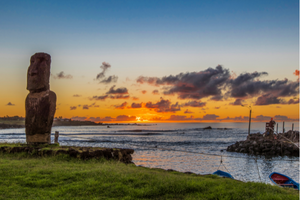 Hanga Roa is both the capital of Easter Island and the only town anywhere on the island. Hanga Roa is a tranquil rural tourist town. Life revolves in and around the market hall. The church is especially noteworthy, where artistic wood carvings mix Catholic and native elements. Three restored ahus complete with upstanding moais can be found by Tahai („Where the sun hides“). On one of them stands Ko Te Riku – the only ‘seeing’ statue on the entire island, with eyes of white coral and black obsidian.
Hanga Roa is both the capital of Easter Island and the only town anywhere on the island. Hanga Roa is a tranquil rural tourist town. Life revolves in and around the market hall. The church is especially noteworthy, where artistic wood carvings mix Catholic and native elements. Three restored ahus complete with upstanding moais can be found by Tahai („Where the sun hides“). On one of them stands Ko Te Riku – the only ‘seeing’ statue on the entire island, with eyes of white coral and black obsidian.
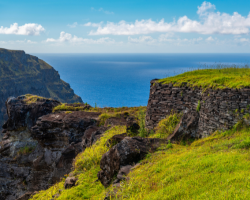 The ceremonial site of Orongo with its small stone houses lies right by the crater of the Ranu Kau volcano. The crater’s edge is 324m high and the crater itself has a diameter of 1.5km. The summit offers a spectacular view over the sea and the three motus. These small islands were the destination for the chosen young men during the Birdman Cult activities that took place at Orongo. One man per clan was sent to swim and climb the motus to steal the first tern’s egg of the year. The chief of the victorious clan then became king of all Rapa Nui for one year.
The ceremonial site of Orongo with its small stone houses lies right by the crater of the Ranu Kau volcano. The crater’s edge is 324m high and the crater itself has a diameter of 1.5km. The summit offers a spectacular view over the sea and the three motus. These small islands were the destination for the chosen young men during the Birdman Cult activities that took place at Orongo. One man per clan was sent to swim and climb the motus to steal the first tern’s egg of the year. The chief of the victorious clan then became king of all Rapa Nui for one year.
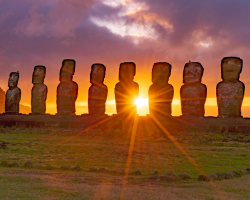 The Moai workshop is one the most interesting sight on Easter Island and lies by the Ranu Raraku volcano. It is here, in the quarry, that the moais were carved from the massive rock. The hillsides of the volcano are still littered with these giant figures, ready for transportation that never happened. Higher up the volcano, more moais can be found in various stages of completion, some still connected to the rock, as if work on them was abandoned from one day to the next. Ascending to the edge of the crater is worthwhile, because there are more moais to be seen lying inside it and the view across the crater lake is amazing, especially at sunset. Not far from the volcano, you will find Ahu Tongariki. 15 restored moai throne upright here and gaze across their island with the Pacific Ocean behind them.
The Moai workshop is one the most interesting sight on Easter Island and lies by the Ranu Raraku volcano. It is here, in the quarry, that the moais were carved from the massive rock. The hillsides of the volcano are still littered with these giant figures, ready for transportation that never happened. Higher up the volcano, more moais can be found in various stages of completion, some still connected to the rock, as if work on them was abandoned from one day to the next. Ascending to the edge of the crater is worthwhile, because there are more moais to be seen lying inside it and the view across the crater lake is amazing, especially at sunset. Not far from the volcano, you will find Ahu Tongariki. 15 restored moai throne upright here and gaze across their island with the Pacific Ocean behind them.
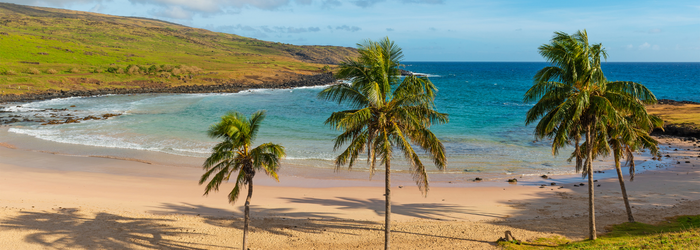
>Anakena beach is situated at the northern end of Easter Island. The sand is white and coconut palms planted there live up to every tourist’s vision of a tropical beach. Anakena is the only beach on the island suitable for swimming. A little further to the east of Anakena you will find the Ahu Te Pito Kura. This is where the Te Pito Kura („The Red Navel“) is located: a large, round smooth stone that is said to have magic powers. According to legend, King Hotu Matua himself brought the stone with him. At a height of 10m / 32ft , the tallest moai ever erected stands on the Ahu Te Pito Kura.


